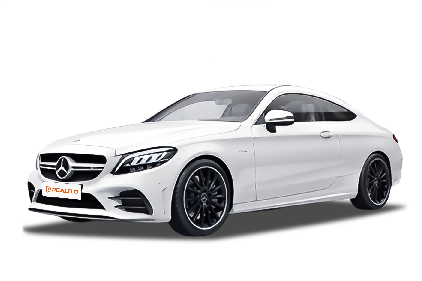Q
How much horsepower does Mercedes C-Class Coupe AMG deliver?
The horsepower of the Mercedes-AMG C-Class Coupé depends on the specific model. Currently, the Mercedes-AMG C 43 4MATIC Coupe (C205) sold in Malaysia is equipped with a 2.0-liter four-cylinder turbocharged engine paired with a 48V mild-hybrid system, which can deliver 408 horsepower. The more powerful Mercedes-AMG C 63 S E PERFORMANCE Coupe (C206) uses a 2.0-liter four-cylinder turbocharged engine and a plug-in hybrid system, with a combined horsepower of up to 680. It can accelerate from 0 to 100km/h in just 3.4 seconds. Compared with the previous generation model (W205 generation), the C 63 S Coupe equipped with a 4.0-liter V8 twin-turbo engine could output 510 horsepower. After the current model is replaced with a four-cylinder hybrid system, it not only has stronger power but also provides the ability for short-term electric driving. All these AMG models are equipped with an enhanced gearbox, high-performance exhaust system, AMG sports suspension, larger brake discs, and exclusive aerodynamic kits, which can bring a more aggressive driving experience both on the Kuala Lumpur circuit and in daily driving. If you want to further optimize the performance, Mercedes-Benz Malaysia also offers upgrade options such as the AMG DYNAMIC PLUS package (including drift mode and more sporty suspension settings).
Special Disclaimer: This content is published by users and does not represent the views or position of PCauto.
Related Q&A
Q
Which model of Mercedes C-Class is the best?
Currently in Malaysia, the Mercedes - AMG C 63 S E Performance (chassis code W206) is the most powerful C - class model. It is equipped with a 2.0L four - cylinder turbo engine and a high - performance PHEV system, with a combined output of up to 680PS and a torque of 1,020Nm, it can accelerate from 0 to 100km/h in just 3.4 seconds. This C63 S inherits AMG's racing genes and is newly added with a rear - axle electric drive, a 4MATIC+ all - wheel - drive system, and an AMG dynamic handling configuration, which significantly improves the handling. At the same time, it has an all - electric range of about 13 kilometers (WLTP standard), meeting the needs of short - distance emission reduction. Compared with the previous V8 C63 S (510PS) of the W205 generation, although the new model has sparked controversy by switching to a four - cylinder engine, it comprehensively surpasses the previous one in terms of power data and acceleration performance and is more in line with the electrification trend. In terms of price, the C63 S E Performance is expected to be priced over RM900,000 in Malaysia (subject to configuration and taxes), belonging to the top - tier performance sedan category. If your budget is a bit lower but you still pursue high performance, you can consider the C43 AMG (408PS).
Q
How to activate start-stop function of Mercedes-Benz C-Class?
The engine start-stop function of Mercedes-Benz C-Class is typically enabled by default. To verify its status or reactivate it, find the button marked with an "A" inside a circular symbol in the cabin - usually located above the left side of the gear lever - and press it to toggle the feature. For touchscreen operation, navigate to the vehicle settings, select either energy management or eco mode, and ensure the start-stop function is checked.
Some variants additionally allow control through the Mercedes me app (requiring phone connection to the car's hotspot before accessing the "Settings" menu), through the instrument cluster display (specific procedures vary by model - consult the owner's manual), or through the central console's driving computer (press the "Menu/Back" or globe-shaped button on the steering wheel to enter settings, then locate the "Engine" or "Engine Start/Stop" option).
The system automatically shuts off the engine when stationary at traffic lights or in congestion after a few seconds of brake application, restarting upon releasing the brake to accelerate or gently turning the steering wheel, thereby reducing fuel consumption and emissions.
Q
Does Mercedes C Class have a timing belt or chain?
The Mercedes C-Class uses a timing chain. The main timing drive methods for engines include timing belts, timing chains, timing gears, etc. Nowadays, most civilian gasoline vehicles use timing belts or chains. Among them, the timing chain is widely used because it requires no maintenance. The Mercedes C-Class models are equipped with timing chains. Compared with the timing belt, although it generates more noise, it has lower long-term usage costs as it doesn't need to be replaced regularly like a timing belt. Generally, you only need to check and adjust its tension every 100,000 kilometers or so. However, even though the timing chain is claimed to be maintenance-free, regular vehicle maintenance and inspections of relevant components are still necessary to ensure the normal operation of the engine.
Q
What audio system does Mercedes C Class have?
The Mercedes C-Class models are generally equipped with Harman Kardon or Burmester audio systems. Harman Kardon was founded in 1953 and is a division of Harman International Industries that specializes in producing home and car audio. Brands like BMW and Land Rover also frequently use its audio systems. It also owns several well - known brands such as JBL and AKG. The Burmester audio system was founded in Germany in 1978. As a high - end brand, it is renowned for its excellent sound quality and a pursuit of audiophile - level sound, and is a favorite among audio enthusiasts. Both of these brands can provide high - quality auditory enjoyment for passengers inside the car. For example, the 2018 Mercedes - Benz AMG C - Class Coupe is equipped with 21 speakers of Burmester and the Sound Plus function.
Q
Is Mercedes C Class equipped with ADAS?
The Mercedes C Class is equipped with ADAS (Advanced Driver Assistance System). It has reached the Level 2 driver assistance level and adopts five exterior cameras, 12 ultrasonic radars, and one millimeter - wave radar. When driving on the highway, the car - following and full - speed adaptive cruise control functions are stable, which can automatically adjust the vehicle speed according to the speed of the vehicle in front, maintain a safe following distance, and relieve the driver's fatigue during long - distance driving. In addition, the Mercedes C Class also comes with systems such as active braking/active safety systems, forward collision warning, electronic stability control, and automatic parking. For example, the active braking system can automatically apply the brakes when necessary to reduce the risk of collision; the automatic parking system can help the driver easily complete the parking maneuver. However, when facing complex road conditions such as on - ramps and road construction, the system's response ability is limited. The driver still needs to stay focused and be ready to take over the vehicle manually at any time.
Q
What suspension does the Mercedes C-Class have?
The Mercedes C-Class is equipped with multi-link independent suspensions both at the front and rear. The front and rear multi-link independent suspensions have numerous advantages in many aspects. They can effectively filter out road vibrations and bumps, providing a smoother driving and riding experience whether you're cruising on rough city streets or uneven rural roads. Additionally, this suspension setup enhances the vehicle's handling characteristics, allowing for better control during turns and maneuvers. The use of this suspension in the C-Class means that passengers can enjoy a more comfortable journey, while drivers can experience superior driving dynamics. For car enthusiasts, this suspension system is also a hallmark of the vehicle's precision engineering, which helps to improve the overall performance and reputation of the Mercedes C-Class.
Q
Does Mercedes C-Class have spare wheel?
The Mercedes C-Class doesn't provide spare tire. Instead, it's typically equipped with run - flat tires. These tires are designed to keep going even when they lose air pressure. With run - flat tires, the vehicle can still keep moving for a certain distance after the loss of tire pressure, without the need to install a spare tire right away, which provides a certain level of convenience and peace of mind for drivers, as they don't have to worry about changing a tire by the roadside immediately. To some extent, this also helps to reduce the vehicle's weight, which may potentially improve fuel efficiency. These run - flat tires usually have special markings like RSC to indicate their technical features.
Q
How to open the sunroof of Mercedes C-Class?
To open the sunroof of Mercedes C-Class, find the SOS button inside the car and push it backward. You can decide the opening degree on your own. For some models without an SOS button, there will be a dedicated button for opening the sunroof in the car, which usually has a pattern similar to a sunroof , press it and then the sunroof will be automatically opened. Besides this opening method, in some models, there is a switch in the center of the roof to control the opening and closing of the sunroof. You can operate it by toggling this switch. After the vehicle is turned off, you can also point the key at the driver - side door and long - press the lock button to close all windows, including the sunroof. Alternatively, you can get close to the driver - side door and long - press the sensor on the outside of the door handle to close them. Knowing these ways to open and close the sunroof allows passengers and drivers to enjoy the comfort brought by the sunroof more freely, such as rapid temperature reduction, fog removal, and improved air circulation.
Q
Is Mercedes C-Class equipped with LED lights?
Yes, the Mercedes C-Class is equipped with LED lights. Both the 2018 Mercedes-Benz AMG C-Class Coupe AMG C 43 4MATIC and the 2018 Mercedes-Benz AMG C-Class Coupe C 63 S come standard with LED headlights. Compared with traditional halogen lights, LED lights offer many advantages, such as better lighting effects, a more stylish appearance, and a longer service life. They can improve visibility on the road, especially when driving at night, in foggy or rainy conditions, ensuring safer driving. In addition, as a luxury car, the use of LED lights also improves the overall luxury of the Mercedes C-Class. In addition, equipped with other standard features like its comprehensive safety system and luxurious interior, the C-Class has become a popular choice among car enthusiasts in the sports car segment.
Q
Does Mercedes C-class have touch screen?
Yes, the latest Mercedes-Benz C-Class (W206 generation) comes standard with an 11.9-inch central touchscreen across the entire lineup. It's equipped with the second-generation MBUX (Mercedes-Benz User Experience) infotainment system, whose high-definition screen supports touch operation and tactile feedback function, allowing you to control functions like navigation, audio, and vehicle settings. The screen also features voice control with "Hey Mercedes" and supports wireless Apple CarPlay and Android Auto connectivity, making it more intelligent and convenient to use.
Moreover, the screen of the Mercedes-Benz C-Class offers clear display and an intuitive UI design. It has a sensitive touch response, which better meets the technological needs of modern users compared to traditional knob controls. In Malaysia, whether it's the entry-level C 200 or the higher-performance C 300 or AMG versions, this touchscreen is standard equipment, providing both drivers and passengers with a more modern interactive experience.
Popular Cars
Model Year
Car Compare
Car Photo
Latest Q&A
Q
How reliable is a 2019 Porsche Macan?
The 2019 Porsche Macan delivers solid reliability, thanks to its proven 2.0T or 3.0T engines that offer consistent power delivery. The PDK dual-clutch transmission is another strong point—it’s both durable and buttery-smooth.
Porsche’s sporty DNA shines through in the Macan’s chassis tuning and all-wheel-drive system, yet it doesn’t compromise everyday comfort. Owner feedback suggests that sticking to the factory maintenance schedule keeps most examples running trouble-free, though be prepared for higher upkeep costs (as with any luxury vehicle).
Its strong resale value speaks volumes about its reputation for dependability. If you’re after driving thrills without sacrificing SUV practicality, the 2019 Macan is a compelling pick. Just be sure to get a pre-purchase inspection and verify full service history—it’ll pay off in the long run.
Q
How much is a 2019 Porsche worth?
The value of a 2019 Porsche depends on the model, mileage, condition, and specs. Take the popular Cayenne, for example—used ones typically go for between RM300k to RM500k. A 911 Carrera might range from RM500k to RM800k, while an entry-level 718 Boxster or Cayman could be around RM250k to RM400k. For luxury sedans like the Panamera, expect prices between RM350k to RM600k, but always check the actual condition and option list.
Porsches hold their value well, especially limited editions or high-performance GT models, but maintenance costs and service history play a big role in resale pricing. If you're buying, stick to official certified pre-owned channels or get a professional inspection. Always verify warranty transfers and repair records.
Pro tip: Compare listings on local used-car platforms and check recent sales data—market demand and inventory fluctuations affect pricing. Also, factory options (like sport packages or premium audio) can boost resale value, while accident history or multiple owners might slash the price by 10-20%.
Q
Does the 2019 Macan have a good sound system?
The 2019 Porsche Macan delivers an impressive audio performance, particularly with the optional Bose® Surround Sound System or the top-tier Burmester® High-End Surround Sound System—both offering an immersive listening experience.
The Bose® setup packs 14 speakers with 665 watts of total power, delivering crisp audio and punchy bass perfect for pop and electronic music. Meanwhile, the Burmester® system steps it up with 16 speakers and 1,000 watts, creating a wider soundstage and superior detail reproduction—ideal for classical or high-resolution tracks.
Both systems integrate seamlessly with Porsche’s standard Communication Management (PCM), supporting Apple CarPlay and multiple audio sources. If sound quality is a priority, be sure to specify your audio preference at purchase—the base model only comes with a standard speaker setup.
For the best performance, play lossless files via USB or high-quality Bluetooth codecs, and keep the system firmware updated for optimal operation.
Q
What is the resale value of a 2019 Macan?
The resale value of a 2019 Porsche Macan depends on factors like condition, mileage, specs, and service history. Current used prices hover between RM250k to RM350k, with higher trims commanding premium prices. As Porsche's entry SUV, the Macan holds its value better than most rivals thanks to brand prestige and sporty DNA – especially models optioned with Sport Chrono or full leather interiors fetching stronger money.
Pro tip: Get a pre-sale inspection and organize your maintenance paperwork – this really helps maximize resale. Macans move quickly in our local used market, with 3-5 year-old examples being the sweet spot when depreciation levels off. If you're upgrading, consider Porsche Approved Certified pre-owned – you'll pay a slight premium over private sales, but the extended warranty and factory refurbishment save headaches down the road.
Q
Is a 2019 Porsche Macan a good car?
The 2019 Porsche Macan is a well-rounded luxury SUV that stays true to Porsche's performance DNA while delivering everyday practicality. It comes with your choice of a peppy 2.0T or more powerful 3.0T engine, paired with Porsche's brilliant 7-speed PDK transmission that shifts like butter. The chassis strikes that sweet spot between sporty handling and comfortable cruising - perfect for both city commutes and weekend backroad blasts.
Inside, you'll find Porsche's typical top-notch craftsmanship with a standard 10.9-inch touchscreen featuring Apple CarPlay. Just don't expect limo-like rear legroom. These things hold their value surprisingly well, though maintenance will cost you more than your average SUV - but then again, you get Porsche's excellent service network.
Among its competitors, the Macan stands out for its driver engagement. If you want more grunt, step up to the Macan S or GTS. One pro tip: if you're shopping used, pay special attention to the PDK's condition and inspect the suspension components. Always better to go through Porsche's certified pre-owned program for that extended warranty peace of mind.
View MoreRelated News

Mercedes-Benz invests in an autonomous driving technology company under Geely named Qianli
AshleySep 25, 2025

Benz launches its first car equipped with solid-state batteries, capable of traveling 1,205 kilometers on a full charge
WilliamSep 10, 2025

Mercedes-Benz electric vehicle design language will also undergo a major change to respond to BMW Neue Klasse.
JamesSep 9, 2025

Mercedes-Benz CLA Electric Opens for Pre-Orders with Over 700km Range
AshleyAug 14, 2025

Mercedes-Benz Unveils Bold Plan: 18 New Models by 2026
Kevin WongAug 6, 2025
View More


















Pros
Cons